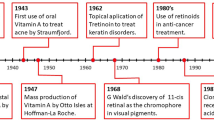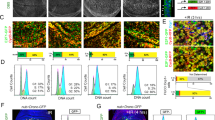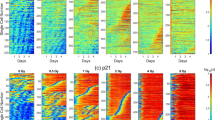Abstract
Stra6 is the retinoic acid (RA)-inducible gene encoding the cellular receptor for holo-retinol binding protein. This transmembrane protein mediates the internalization of retinol, which then upregulates RA-responsive genes in target cells. Here, we show that Stra6 can be upregulated by DNA damage in a p53-dependent manner, and it has an important role in cell death responses. Stra6 expression induced significant amounts of apoptosis in normal and cancer cells, and it was also able to influence p53-mediated cell fate decisions by turning an initial arrest response into cell death. Moreover, inhibition of Stra6 severely compromised p53-induced apoptosis. We also found that Stra6 induced mitochondria depolarization and accumulation of reactive oxygen species, and that it was present not only at the cellular membrane but also in the cytosol. Finally, we show that these novel functions of Stra6 did not require downstream activation of RA signalling. Our results present a previously unknown link between the RA and p53 pathways and provide a rationale to use retinoids to upregulate Stra6, and thus enhance the tumour suppressor functions of p53. This may have implications for the role of vitamin A metabolites in cancer prevention and treatment.
Similar content being viewed by others
Log in or create a free account to read this content
Gain free access to this article, as well as selected content from this journal and more on nature.com
or
Abbreviations
- ATRA:
-
all-trans retinoic acid
- DAPI:
-
4′,6-diamidino-2-phenylindole, dihydrochloride
- DCF:
-
2′,7′-dichlorodihydrofluorescein diacetate
- Dox:
-
doxorubicin
- Fpg:
-
formamidopyrimidine DNA glycosylase
- hOGG1:
-
human 8-oxoguanine DNA glycosylase 1
- PI:
-
propidium iodide
- RA:
-
retinoic acid
- RBP:
-
retinol binding protein
- ROS:
-
reactive oxygen species
- tBH:
-
tert-butyl-hydroxyperoxide
- TRAIL:
-
TNF-related apoptosis-inducing ligand
References
Lane DP . Cancer. p53, guardian of the genome. Nature 1992; 358: 15–16.
Prives C . Signaling to p53: breaking the MDM2-p53 circuit. Cell 1998; 95: 5–8.
Kubbutat MH, Jones SN, Vousden KH . Regulation of p53 stability by Mdm2. Nature 1997; 387: 299–303.
Prives C, Hall PA . The p53 pathway. J Pathol 1999; 187: 112–126.
Werness BA, Levine AJ, Howley PM . Association of human papillomavirus types 16 and 18 E6 proteins with p53. Science 1990; 248: 76–79.
Shay JW, Wright WE, Werbin H . Defining the molecular mechanisms of human cell immortalization. Biochim Biophys Acta 1991; 1072: 1–7.
Vogelstein B, Kinzler KW . p53 function and dysfunction. Cell 1992; 70: 523–526.
Bond J, Haughton M, Blaydes J, Gire V, Wynford-Thomas D, Wyllie F . Evidence that transcriptional activation by p53 plays a direct role in the induction of cellular senescence. Oncogene 1996; 13: 2097–2104.
Levine AJ . p53, the cellular gatekeeper for growth and division. Cell 1997; 88: 323–331.
Vousden KH . p53: death star. Cell 2000; 103: 691–694.
Levine AJ, Hu W, Feng Z . The P53 pathway: what questions remain to be explored? Cell Death Differ 2006; 13: 1027–1036.
Blomhoff R, Blomhoff HK . Overview of retinoid metabolism and function. J Neurobiol 2006; 66: 606–630.
Duester G . Retinoic acid synthesis and signaling during early organogenesis. Cell 2008; 134: 921–931.
Chambon P . The molecular and genetic dissection of the retinoid signalling pathway. Gene 1993; 135: 223–228.
Chambon P . A decade of molecular biology of retinoic acid receptors. FASEB J 1996; 10: 940–954.
Altucci L, Gronemeyer H . The promise of retinoids to fight against cancer. Nature reviews. Cancer 2001; 1: 181–193.
Park SH, Lim JS, Jang KL . All-trans retinoic acid induces cellular senescence via upregulation of p16, p21, and p27. Cancer Lett 2011; 310: 232–239.
Asou N . 2. All-trans retinoic acid in the treatment of acute promyelocytic leukemia. Intern Med 2007; 46: 91–93.
Taneja R, Bouillet P, Boylan JF, Gaub MP, Roy B, Gudas LJ et al. Reexpression of retinoic acid receptor (RAR) gamma or overexpression of RAR alpha or RAR beta in RAR gamma-null F9 cells reveals a partial functional redundancy between the three RAR types. Proc Natl Acad Sci USA 1995; 92: 7854–7858.
Chazaud C, Bouillet P, Oulad-Abdelghani M, Dolle P . Restricted expression of a novel retinoic acid responsive gene during limb bud dorsoventral patterning and endochondral ossification. Dev Genet 1996; 19: 66–73.
Kawaguchi R, Yu J, Honda J, Hu J, Whitelegge J, Ping P et al. A membrane receptor for retinol binding protein mediates cellular uptake of vitamin A. Science 2007; 315: 820–825.
Heller J . Interactions of plasma retinol-binding protein with its receptor. Specific binding of bovine and human retinol-binding protein to pigment epithelium cells from bovine eyes. J Biol Chem 1975; 250: 3613–3619.
Pasutto F, Sticht H, Hammersen G, Gillessen-Kaesbach G, Fitzpatrick DR, Nurnberg G et al. Mutations in STRA6 cause a broad spectrum of malformations including anophthalmia, congenital heart defects, diaphragmatic hernia, alveolar capillary dysplasia, lung hypoplasia, and mental retardation. Am J Hum Genet 2007; 80: 550–560.
Ruiz A, Mark M, Jacobs H, Klopfenstein M, Hu J, Lloyd M et al. Retinoid content, visual responses and ocular morphology are compromised in the retinas of mice lacking the retinol-binding protein receptor, STRA6. Invest Ophthalmol Vis Sci 2012; 53: 3027–3039.
Berry DC, O'Byrne SM, Vreeland AC, Blaner WS, Noy N . Cross-talk between signalling and vitamin A transport by the retinol-binding protein receptor STRA6. Mol Cell Bio 2012; 32: 3164–3175.
Berry DC, Jin H, Majumdar A, Noy N . Signaling by vitamin A and retinol-binding protein regulates gene expression to inhibit insulin responses. Proc Natl Acad Sci USA 2011; 108: 4340–4345.
Nair AK, Sugunan D, Kumar H, Anilkumar G . Case-control analysis of SNPs in GLUT4, RBP4 and STRA6: association of SNPs in STRA6 with type 2 diabetes in a South Indian population. PloS One 2010; 5: e11444.
Ohtsuka T, Ryu H, Minamishima YA, Macip S, Sagara J, Nakayama KI et al. ASC is a Bax adaptor and regulates the p53-Bax mitochondrial apoptosis pathway. Nat Cell Biol 2004; 6: 121–128.
Munoz-Fontela C, Macip S, Martinez-Sobrido L, Brown L, Ashour J, Garcia-Sastre A et al. Transcriptional role of p53 in interferon-mediated antiviral immunity. J Exp Med 2008; 205: 1929–1938.
Mungamuri SK, Benson EK, Wang S, Gu W, Lee SW, Aaronson SA . p53-mediated heterochromatin reorganization regulates its cell fate decisions. Nat Struct Mol Biol 2012; 19: 478–484.
Sugrue MM, Shin DY, Lee SW, Aaronson SA . Wild-type p53 triggers a rapid senescence program in human tumor cells lacking functional p53. Proc Natl Acad Sci USA 1997; 94: 9648–9653.
Wei CL, Wu Q, Vega VB, Chiu KP, Ng P, Zhang T et al. A global map of p53 transcription-factor binding sites in the human genome. Cell 2006; 124: 207–219.
Macip S, Igarashi M, Berggren P, Yu J, Lee SW, Aaronson SA . Influence of induced reactive oxygen species in p53-mediated cell fate decisions. Mol Cell Biol 2003; 23: 8576–8585.
Polyak K, Xia Y, Zweier JL, Kinzler KW, Vogelstein B . A model for p53-induced apoptosis [see comments]. Nature 1997; 389: 300–305.
Raj L, Ide T, Gurkar AU, Foley M, Schenone M, Li X et al. Selective killing of cancer cells by a small molecule targeting the stress response to ROS. Nature 2011; 475: 231–234.
Szeto W, Jiang W, Tice DA, Rubinfeld B, Hollingshead PG, Fong SE et al. Overexpression of the retinoic acid-responsive gene Stra6 in human cancers and its synergistic induction by Wnt-1 and retinoic acid. Cancer Res 2001; 61: 4197–4205.
Sonneveld E, van den Brink CE, van der Leede BM, Schulkes RK, Petkovich M, van der Burg B et al. Human retinoic acid (RA) 4-hydroxylase (CYP26) is highly specific for all-trans-RA and can be induced through RA receptors in human breast and colon carcinoma cells. Cell Growth Differ 1998; 9: 629–637.
Vousden KH, Lu X . Live or let die: the cell’s response to p53. Nat Rev Cancer. 2002; 2: 594–604.
Murray-Zmijewski F, Slee EA, Lu X . A complex barcode underlies the heterogeneous response of p53 to stress. Nature reviews. Mol Cell Bio 2008; 9: 702–712.
Tan L, Wray AE, Ross AC . Oral vitamin A and retinoic acid supplementation stimulates antibody production and splenic Stra6 expression in tetanus toxoid-immunized mice. J Nutr 2012; 142: 1590–1595.
Tice DA, Szeto W, Soloviev I, Rubinfeld B, Fong SE, Dugger DL et al. Synergistic induction of tumor antigens by Wnt-1 signaling and retinoic acid revealed by gene expression profiling. J Biol Chem 2002; 277: 14329–14335.
Masgras I, Carrera S, de Verdier PJ, Brennan P, Majid A, Makhtar W et al. Reactive oxygen species and mitochondrial sensitivity to oxidative stress determine induction of cancer cell death by p21. J Biol Chem 2012; 287: 9845–9854.
Carrera S, de Verdier PJ, Khan Z, Zhao B, Mahale A, Bowman KJ et al. Protection of cells in physiological oxygen tensions against DNA damage-induced apoptosis. J Biol Chem 2010; 285: 13658–13665.
Duarte TL, Cooke MS, Jones GD . Gene expression profiling reveals new protective roles for vitamin C in human skin cells. Free Radic Biol Med 2009; 46: 78–87.
Duarte TL, Almeida GM, Jones GD . Investigation of the role of extracellular H2O2 and transition metal ions in the genotoxic action of ascorbic acid in cell culture models. Toxicol Lett 2007; 170: 57–65.
Bartholin L, Powers SE, Melhuish TA, Lasse S, Weinstein M, Wotton D . TGIF inhibits retinoid signalling. Mol Cell Biol 2006; 26: 990–1001.
Acknowledgements
We thank S A Aaronson for his help in the initial stages of this project. We thank S Cowley and M J Dyer for useful discussions and critical reading of the manuscript. We also thank K Straatman and the Advanced Image Facilities for assistance with immunofluorescence experiments. This work was funded by the MRC (www.mrc.ac.uk, New Blood Lectureship Research Support Funding). S Carrera held a predoctoral fellowship from CONACYT (www.conacyt.mx, fellow no.200721). Work in the lab of GDDJ is supported by the European Union (ECNIS, www.ecnis.org), Hope Against Cancer (www.hfcr.org) and Cancer Research UK (www.cancerresearchuk.org). S Cuadrado was a predoctoral fellowship holder from Junta de Castilla y León, Consejería de Educación (www.educa.jcyl.es). This work was also partially supported by grants from Fondo de Investigaciones Sanitarias (FIS, PI08/1813) from the Spanish Government (www.mineco.gob.es/) to E.V.
Author information
Authors and Affiliations
Corresponding author
Ethics declarations
Competing interests
The authors declare no conflict of interest.
Additional information
Edited by RA Knight
Supplementary Information accompanies this paper on Cell Death and Differentiation website
Rights and permissions
About this article
Cite this article
Carrera, S., Cuadrado-Castano, S., Samuel, J. et al. Stra6, a retinoic acid-responsive gene, participates in p53-induced apoptosis after DNA damage. Cell Death Differ 20, 910–919 (2013). https://doi.org/10.1038/cdd.2013.14
Received:
Revised:
Accepted:
Published:
Issue date:
DOI: https://doi.org/10.1038/cdd.2013.14



